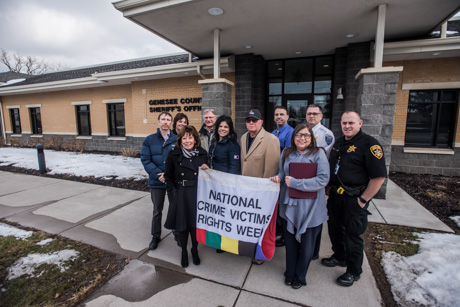Stories from
Expert in addiction says prevention is most effective cure for opioid epidemic

There is a lot of attention paid to opioid addiction treatment, Dr. Richard Blondell told an audience at the City Church Generation Center in Batavia today, but not enough effort is given to preventing addiction in the first place.
"The bottom line of this opioid epidemic is we cannot treat our way out of this epidemic," Blondell said. "We cannot incarcerate out of this epidemic. We can't legislate our way out of this epidemic. What we really have to do is prevention."
Blondell is vice chair of addiction medicine and a professor in the Department of Family Medicine at SUNY Buffalo. He spoke today at a workshop for faith leaders sponsored by the Genesee-Orleans-Wyoming Opioid Task Force.
Drawing on science, history and statistics, Blondell made the case that it's very difficult to successfully treat somebody for opioid addiction; therefore, to end the current epidemic, society needs to produce fewer addicts.
That begins with doctors, he said but includes families and individuals who need to be more aware and better educated about addiction and prevention.
The causes of addiction are both genetic and environmental, Blondell said.
About 10 percent of the population is genetically susceptible to opioid addiction. Those people, when exposed to opioids, usually through prescription medication, are much likely to become addicts.
The addiction for them is a disease.
An addict has about a 5 percent chance of dying in any given year.
"The average life expectancy of a heroin addict is about 10 years, most are gone in 20," Blondell said.
Much of the blame for the opioid epidemic can be placed on Arthur M. Sackler, a medical marketing executive in the 1950s who, among other things, introduced the world to Valium, the first multimillion drug.
"It didn't treat anything actually," Bondell said. "Even though Valium was the number one prescribed drug in the country it was not clear what disease it treated."
The Sackler family went on to own Perdue Pharma, the company that introduced OxyContin.
That pain pill was sold to doctors as non-addictive if used for pain.
Then the insurance companies got involved, Blondell said. They stopped funding pain-management regimes, which could cost thousands of dollars but were effective, in favor of prescription pain medications. And if doctors didn't prescribe enough pain pills, they would get low patient satisfaction scores from patients who said, "he didn't do anything for my pain."
Doctors started prescribing opioid-based pain medications "like skittles," Blondell said.
Patients who become addicted to pain pills often, usually, turn to heroin, which is cheaper and easier to get. About 75 percent of heroin addicts started with a prescription to either the addict himself or to a friend or family member.
There are two types of treatment for addicts, neither high success rates -- counseling or medication.
In counseling, an addict receives psychological therapy, or they might live in a home and where they can learn adult life skills but if they are physically addicted, brain condition related to addiction is not treated. That is where medication, such as methadone, come in.
Blondell said all treatment methods should continue but that isn't the final answer on the epidemic. We've never treated our way out of an epidemic, he said.
People who say addiction is a choice really don't understand opioid addiction, Blondell said.
Everybody is addicted to something. Addiction is essential to survival. We're all addicted, for example, to water.
But what substances, such as illicit drugs and alcohol do, is trick the brain into thinking that substance is a higher priority than other addictions, such as food.
"So people say to me, this is a behavior," Blondell said. "It's not really a mental illness or it's not a disease. It's not a disorder. It's really just a behavioral problem. To which my question is, what organ in the body produces behavior? Is it the kidneys? Is it the liver? No, it's the brain. So it's the brain that produces the behavior that we see and pass judgment on."
If we're going to end the epidemic, Blondell said, doctors need to be more cautious and judicious in when and how they prescribe pain medications. Patients who receive them need to be better educated about taking the prescribed amount for only a short period of time. Parents need to ensure they control the distribution of pain medication to their teen children, and ensure they actually take them when dispensed so they're not hoarded so five or six can be taken at a time. Everybody needs to be better educated about the nature of addiction and how to avoid it.
Soil and Water District continues to look after Genesee County's environment

The job of Soil and Water Conservative, District Manager Brad Mudrzynski, told the Public Service Committee on Monday during a department review, is pretty straightforward at its most basic: Keep soil healthy; keep it on dry land; keep it out of water, so water is kept clean.
Mudrzynski became the director in January, the second since George Squires retired a couple of years ago after 31 years of service to the county, but Mudrzynski, who is from Elba, said the district has continued to operate without missing a beat.
Genesee County's soil and water district was established in 1944. Every county in the state has a soil and water district. The county budgets about $150,000 annually to fund the district. That pays for personnel, currently four full-time staffers and one part-time employee, and it's up to the district to apply for grants and aid to fund its programs.
"We have a good core," Mudrzynski said. "I hope I get to keep my core because they are really good people. They all know what they're doing."
The current staff is Molly Cassatt, a technician (the former director who volunteered to change rolls), Bob Berkemeier, senior technician, Tim Welch, technician, and Laura Bestehorn, clerk-treasuer.
In Genesee County, most programs are focused on agriculture but the agency also works with municipalities. For example, soil and water is using a $6,000 state grant to fund a hydroseeding program with the towns.
Hydroseeding, rather than just spreading grass seed on the ground, helps prevent runoff and soil erosion.
Other programs and services include tree and shrub planting, fish stocking, an Envirothon, recycling events, permit assistance, guidance for invasive species control, and erosion control design.
In 2018, the district secured nine grants worth $1.2 million.
Mudrzynski said soil and water districts are unique in the state because they operate as quasi-state agencies but with local control, which makes them more nimble and responsive to local needs.
Hens gives report to Legislature on county's $70 million bridge inventory
There are 95 bridges and 256 culverts in the county's infrastructure inventory and combined they're worth about $70 million, County Highway Superintendent Tim Hens told members of the Public Service Committee on Monday.
That's a conservative estimate, Hens said.
He arrived at the number based on the amount spent on bridge and culvert replacement over the past three years without adjusting for inflation.
Genesee County is one of three counties in the state that are economically responsible for all bridges and culverts on non-state roads, including those in towns and villages. In every other county, towns and villages must maintain and replace old bridges.
It's been that way since 1939 when the board of supervisors passed legislation giving county control of bridges and culverts.
A bridge (defined as more than 20 feet long) can be expected to have a safe, useful life of 50 years. The average bridge in the county was constructed in 1968, Hens said.
To keep up with the replacement cycle of bridges, the county needs to replace two bridges a year but in recent years, with cuts in federal aid, the county has only been able to replace one bridge a year.
Typically, state and federal aid helps pay for bridge and culvert replacement but as that aid is cut back, the county may need to turn to other sources of local revenue, such as sales tax.
Revised secondhand dealer law narrows focus to pawn shops, coin dealers

A proposed local law aimed at curbing property thefts is back before the County Legislature after undergoing revisions to more narrowly focus its intent on pawn shops and other businesses most commonly favored by criminals to fence stolen goods.
County Attorney Kevin Earl worked with a variety of interested parties, including District Attorney Lawrence Friedman and Chief Deputy Jerome Brewster to draft proposed language that would still meet the intent of the legislation, but ensure it only hit its target without potentially adding an unintended regulatory burden to other local businesses.
The original bill was introduced in November and met some initial opposition from some members of the Legislature and some local business owners.
The key change of the law narrows the scope of the regulations to businesses known as "pervasively regulated." Prior case law has established that certain business activities can be monitored by the government without a warrant because of the nature of the business. In New York, these already include pawn shops, coin dealers, chop shops, and other enterprises that can be used as fronts for stolen property.
The change ensures the law can't be used to impose regulations on commercial thrift-type stores, used book and record stores, antique stores, or businesses that resell gift cards, among other establishments that might have been swept up in the prior broader language of the law.
Public Services Committee Chair Shelly Stein said during yesterday's committee meeting that it's important to remember the purpose of the law.
"We are trying to assist victims of theft and robbery in the county," Stein said.
Even so, the revised bill isn't supported by all members of the Legislature. Both legislators John Deleo and Andrew Young said they are uncomfortable adding another layer of regulation on private enterprise.
"We have one pawn shop here and we're creating more mandated laws when we get upset when the state puts mandates on us," Deleo said. "I don't think it's right. I have faith in law enforcement that if we have a problem, we can solve it. I don't care how much lipstick we put on this, I have a hard time buying into it. I guess I have more faith in law enforcement.
After the meeting, Young said he still isn't satisfied with the language of the law.
"It has been suggested that the decision to be made to pass this law is easy because it is simply to choose between victims of stolen goods and potential criminals," Young said. "I don’t agree that is what it is about. The decision to be made is to weigh the cost of additional government rules, regulations and reporting requirements against the value those government-imposed burdens provide towards assisting victims of theft.
"The changes made make this law better and somewhat less intrusive. I am not sure we have reached the point where the value of this law outweighs the cost."
Another significant change is the elimination of the licensing fee for a qualified secondhand dealer.
"We did this to address the suggestion that this was only a money grab by the county," said County Clerk Michael Cianfrini. "We wanted to eliminate that concern."
Earl said he's confident that changes in the bill's language will help it withstand any potential Constitutional challenge.
Niagara County passed a new law similar in language to the original draft of Genesee County's law and Earl said officials up there, after he shared his concerns with them about the local law, don't intend to make changes.
"Niagara County had nobody show up at their public hearing," Earl said. "There were no objections. It's probably a good thing we had objections up front or we might have had problems on the back end."
Brewster said just discussion of the law has compelled Pawn King on Veterans Memorial Drive, Batavia, to start using Leads Online, a digital service used by pawn shops to enter items received into a searchable database. Law enforcement agencies can then subscribe to the service (there's no cost to the merchants who participate) so they can see what items are coming into the shop and check the list of items reported stolen.
Pawn King was already using the service in other counties where it does business because those counties legally compel Pawn King to use Leads Online.
Brewster said passage of a similar law locally will ensure Pawn King continues to use the service and will help ensure their compliance is thorough.
Businesses required to record transactions and hold items for at least 10 days under the law could lose their license and be forced to close if found out of compliance.
Mike Barrett, owner of Barrett Marine, said after the meeting that with the revisions, he's more comfortable that the new law. If passed, it won't apply to Barrett's business, but the owner of John G. Cooper Coin Shop in Le Roy said at age 76, this law may be a signal that it's time to retire.
Previously:
UMMC's severe maternal morbidity rate low compared to state, nation
According to data compiled by the Center for Disease Control, a federal agency, and compiled by USA Today, United Memorial Medical Center has one of the best rates of mothers avoiding serious complications during childbirth in New York and the nation.
UMMC's severe maternal morbidity (SMM) rate for births to all mothers is 0.09 percent, compared to 1.8 percent for New York and a 1.4-percent rate nationwide.
SMM includes unexpected outcomes of labor and delivery that result in significant short- or long-term consequences to a woman’s health, according to the CDC.
The rate for UMMC is based on 2,341 deliveries from 2014 through 2017.
Dr. Tara Gellasch, chief medical officer for UMMC, and a physician at Batavia's Women Care Center, said UMMC's rating reflects the hospital's commitment to quality care and the support of the Rochester Regional Health system.
"Due to a myriad of potential conditions that can increase risk, maternal mortality is a growing concern in New York State and throughout the country," Gellasch said. "At United Memorial Medical Center, our providers and staff are trained to identify patients at risk so we can work with our Rochester Regional Health experts in high-risk obstetrics to provide these patients with the prenatal care they need.
"Our team is proud that we have kept maternal mortality rates consistently low and, as we do in all areas of care, we continue to evaluate our work and find ways to raise the bar for the future."
The severe maternal morbidity rate "is a composite measure of things that can go wrong at the hospital before, during or after delivery – heart attacks, strokes, blood transfusions, hysterectomies and other perilous emergencies that can permanently harm or even kill a new mother," reported USA Today.
Because the SMM rate is especially a concern for black mothers, the newspaper also reported on the rate and deaths for black mothers at UMMC during the study period.
The rate of episiotomy, an incision made in the vagina to assist during difficult births but not recommended by most health care experts, is 1.2 percent at UMMC compared to 7.8 percent at hospitals in 13 other states.
The cesarean rate at UMMC is 18.5 percent compared to a national rate, among hospitals that report the rate -- some do not disclose it -- is 19.9 percent.
January's local unemployment rate lower than previous year
While Genesee County's unemployment rate jumped to 5.0 percent in January it was still a point-and-a-half lower than a year earlier for the same month.
The Department of Labor released the county's unemployment rate on Friday.
January's unemployment rate is traditionally one of the highest rates of any month in the year and last year it was 6.4 percent.
In December, the local rate was 4.1 percent.
There were 30,000 local residents reported in the labor force for January of this year compared to 29,500 the previous January.
Of those 30,000, 28,500 had jobs compared to 27,600 with jobs the previous year.
The number reported without work but seeking employment dropped from 1,900 to 1,500.
As for the number of private-sector jobs in the county, there were 16,300 reported in January compared to 16,200 the previous year.
Gas prices jump sharply
Press release from AAA:
Today’s national average price for a gallon of gasoline is $2.55, up 7 cents from last week. One year ago, the price was $2.55 as well. The New York State average is $2.66 – up 7 cents from last week. A year ago, the NYS average was $2.69. AAA Western and Central New York (AAA WCNY) reports the following averages:
- Batavia -- $2.60 (up 10 cents since last week)
- Buffalo- - $2.58 (up 7 cents since last week)
- Ithaca -- $2.69 (up 10 cents since last week)
- Rochester -- $2.67 (up 10 cents since last week)
- Rome -- $2.67 (up 8 cents since last week)
- Syracuse -- $2.66 (up 9 cents since last week)
- Watertown -- $2.68 (up 9 cents since last week)
Increasing demand for gasoline and tightening supply have helped to push prices higher this week. In its latest weekly petroleum status report, the Energy Information Administration (EIA) released new data that shows the spring driving season is certainly ahead for American motorists.
AAA is seeing an increase in requests for maps and tour books to popular driving destinations including Myrtle Beach and Charleston, S.C.
Gasoline demand is up while total domestic gasoline stocks are falling. As demand strengthens and gas stocks tighten, pump prices will likely follow suit and continue to increase. A springtime jump in prices is typical with increased demand and the changeover to the more expensive summer blend gasoline in the coming weeks.
VIdeo: St. Patrick's Day in Batavia, 2019
Photo: Eagle in the Agri-Business Park

Frank Capuano took this picture of an eagle he spotted this morning feasting on a carcass in the Genesee Valley Agri-Business Park.
Videos: No Blarney! at HLOM
No Blarney! performed a concert of traditional Irish music Friday night at the Holland Land Office Museum.
Here are two videos from that performance, one of "Drink It Up, Man," and the other "Drunken Sailor."
Thank you to No Blarney! and the audience for allowing me to make these two videos. Happy St. Patrick's Day!
Woman knocks out windows with shovel and flees
A caller reports that a woman showed up at a residence on Williams Street in Batavia and knocked the windows out with a shovel.
She then left in a dark-colored Ford pickup truck.
Police are searching the area.
Photo: Reading night dancing at Jackson School

Children dance to the music of the Hill Brothers during annual Family Reading Night at Jackson School in Batavia.
The entertainment followed sessions of various people from the community reading to the children in their classrooms at the school.


Batavia man admits to sexual abuse involving woman unable to give consent

A 43-year-old Batavia resident admitted in Genesee Count Court this week to one count of sexual abuse, 1st, for a sexual act involving a woman deemed to be incapable of giving consent.
Adam Brokaw, of Northern Boulevard, faces up to 10 years on probation and six months in jail following the guilty plea.
Sentencing is scheduled for 2:30 p.m., April 26.
Brokaw, at the time of his arrest in July, was a corrections officer at the Albion Correctional Facility.
Investigators said at the time that the incident took place at 2 a.m., Nov. 11, 2017 after a party at his residence.
No significant program cuts anticipated as City School District looks to trim spending by $750K
With each budget revision of the Batavia City School District budget for 2019-2020, Business Administrator Scott Rozanski gets a little closer to trimming $750,000 in spending.
He said school officials are also hoping state aid will increase for the year so the district can keep the property tax levy from growing more than 4.69 percent.
In the latest revision, Rozanski has penciled in $51,118,155 in spending.
He expects about $25 million in state aid, though hoping for more, and local revenue of more than $27.4 million. That would include spending $3.1 million in fund balance with a tax levy of $20,608,000.
But that tax levy amount would mean an increase of 8.78 percent, well above the legal limit of the state's property tax law.
Over three revisions, Rozanski has already trimmed off more than $500,000 but he still needs to find enough savings to get the levy down to $19,834,000, or lower.
A levy under that amount would allow the budget to pass on a simple majority and ensure district property owners would be eligible for a tax rebate from the state in the fall.
A Tuesday's school board meeting, Rozanski said administrators and department chairs found $166,000 in purchases that could be canceled or delayed.
The district will also be able to save $120,000 by letting positions stand vacant after staff retirements.
When asked by a board member why the positions weren't being filled, Rozanski said, "We need to look at things a little bit differently in how we're operating so we're looking for savings."
Those are the kind of cuts Rozanski continues to look for in the budget. He said he doesn't anticipate any significant program cuts.
Overall, the school district expects to cut spending by more than $2.8 million but $2.1 million of that spending came from a statewide bond initiative five years ago that allowed school districts through the state to improve technology-related infrastructure. The cut in revenue and expenditure offset each other as the program comes to a close.
The other $750,000 that must be cut is the result of an NYS Comptroller audit a few years ago that found the school district was estimating revenue correctly but underestimating expenditures in its annual budgets. This was leading to a growing fund reserve. The reserve had become 7 or 8 percent of overall expenditures when it shouldn't be more than 4 percent. That money, the report noted, should be returned to taxpayers in the form of tax cuts.
The district had a reserve fund for debt service but the Comptroller said debt service should be paid out of the general fund so, over the past two years, the district has been transferring money from the debt service fund to the general fund. The debt service fund is now tapped out, hence the need to cut $750,000 in expenses.
Batavia woman accused of selling methadone to a task force agent

A 39-year-old resident of West Main Street Road, Batavia, has been arrested and accused of selling a quantity of methadone to an agent of the Local Drug Task Force on two occasions.
Leona J. Polk is charged with two counts of criminal sale of a controlled substance 4th, a Class C felony.
Polk was arraigned in Genesee County Court on Thursday and given her status as a lifelong Batavia resident and her lack of any prior criminal record, she was released on her own recognizance.
She was arrested March 8 and held without bail until her appearance before Judge Charles Zambito on Thursday.
She is accused of making the sales on June 17 and 18.
Video: 12th Annual Tech Wars at GCC
Students from throughout the region competed Thursday at Genesee Community College in the 12th Annual Tech Wars, which gives them a chance to test out their ideas and designs in engineering and technology-related contests against students from other schools.
Sentencing delayed for teen who shot killer on Central Avenue
The sentencing of Samual Blackshear, the Batavia teenager who shot murderer Nathaniel Wilson in the leg after Wilson had stabbed Terry J. Toote outside a residence on Central Avenue, was delayed again today because his attorney received information that could effect Blackshear's eligibility for youthful offender status.
Blackshear entered a guilty plea in November to a single count of criminal possession of a weapon.
The plea agreement, which satisfied an indictment that included counts of attempted assault in the first degree, assault in the second degree, and two counts of criminal possession in the second degree, came with the promise that Judge Charles Zambito would consider granting the then 17-year-old youthful offender status. That would seal his court and criminal record in this case; the defendant is then never required to disclose the conviction to colleges or on job applications.
In preparing for sentencing, James Hinman did not receive a victim's statement from Wilson and did not believe such a statement existed.
Today, he learned that while Wilson did not make a victim's impact statement, he did make statements during his interview for his own pre-sentence investigation, that could have a bearing on the Blackshear case. Hinman asked for time to review those statements.
The content of Wilson's statements was not revealed in court.
In defending Blackshear, Hinman has maintained that Blackshear acted to protect the lives of people at the scene of May 17 murder. While the justification defense might have swayed a jury on the assault charges, Hinman did not dispute that Blackshear came into possession of a handgun he wasn't licensed to carry.
The gun allegedly came from Jennifer Urvizu-Hanlon, 48, then a local businesswoman, who did have a license for the gun. Her case is still pending.
Blackshear's case was continued to 3:30 p.m., March 2.
Even if granted youthful offender status, Blackshear could still be sent to prison for up to four years, or Zambito could put him on probation immediately.
Wilson, who admitted to second-degree murder, was sent to prison for a minimum of 20 years.
Crime Victims' Rights Week: Committee planning discussion of 1987 crash that claimed four lives in Pembroke

Crime Victims' Rights Week in Genesee County will be commemorated April 7-13 with a special presentation at Genesee Community College from 8:15 a.m. to 1 p.m. on Monday, April 8, examining a fatal car accident that has become a key part of Genesee County history.
"Honoring Our Past. Creating Hope for the Future" will look back on a 1987 head-on collision that took the lives of three students in Pembroke and their driver's education instructor.
The panel for the discussion includes:
- Sheriff's Office Crash Scene Investigator -- Judge James Orr
- Prosecuting District Attorney -- Judge Robert C. Noonan
- Pembroke School teacher -- Gregory Kinal
- Family members: Deputy Patrick Reeves
Reeves is the brother of Rhonda Reeves, who was 17 the day a car driven by Lyndon Goodell, then 23, hit the car she and her classmates were in. Also killed were students Eric Hamm-Johnson, Mindy Beals, and 55-year-old instructor Patrick Collins.
Goodell, a Batavia resident who had already served a stint in prison for burglary, was eventually convicted of manslaughter and vehicular manslaughter. He was sentenced to seven to 15 years in prison.
A wrongful-death lawsuit filed by the victims' families found Goodell and his passenger, Carol Rokicki Elder, equally at fault. Rokicki Elder gave Goodell the keys to her car and the bottle of whiskey that they shared.
The cost to attend is $10; students and seniors pay $5. Make checks out to: Genesee Justice (You can write Criminal Justice Day 2019 in the memo line.)
To attend this event, mail payment by April 1 along with your name, address, city, state, Zip code, phone # and email address.
Mail to:
Genesee Justice
14 W. Main St.
Batavia, NY 14020
For more details or questions, contact Holly McAllister, of Genesee Justice, at 344-2550, ext. 3929, or email her at: Holly.McAllister@co.genesee.ny.us
Click here for a PDF registration form.
Photo: Crime victim's week committee: Bob Riccobon, Sue Gagne, Gregory Kinal, Catherine Uhley, Kimberly Perl, Judge Robert Noonan, Undersheriff Brad Mazur, Rosanne DeMare, Assistant Chief (Batavia PD) Todd Crossett, and Deputy Patrick Reeves.
For previous coverage of the event planned April 8, 2019, click here.
Pagination
- First page
- Previous page
- …
- 325
- 326
- 327
- 328
- 329
- …
- Next page
- Last page
